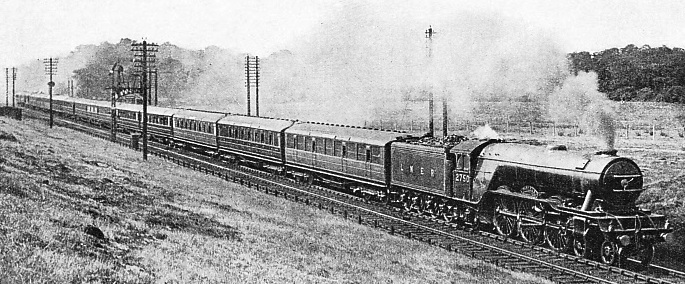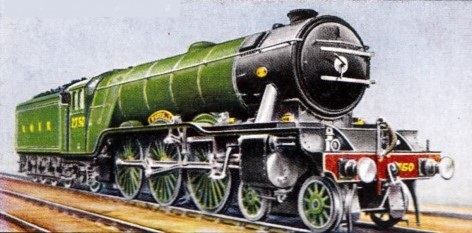
© Railway Wonders of the World 2012-


108 mph on the LNER
New World’s Record by “Pacific” Locomotive

The LNER “Super-
ALL previous speed records for steam-
This marvellous running was done in the course of experimental runs on the LNER from London to Newcastle and back to test further the capabilities for high-
On the down journey Kings Cross was left at 9.08 a.m. and although the running was highly creditable, no records were broken, the highest speed being 88.6 mph between Hitchin and Huntingdon. An unfortunate delay was caused by the derailment of some coal trucks near Doncaster, which entailed single line working and occasioned not only slow running for some distance, but an actual stop for 19 sec. In all, about 7 min. were lost through this check.
After York had been passed at reduced speed, some excellent running was done and over the slightly adverse grades an average of 80 mph was kept up for almost 40 miles, with the result that all losses were recovered and Darlington was passed before schedule time.
The arrival at Newcastle was 3 min. early, the overall time from King’s Cross having been only 3 hr. 57 min. The average speed was 67½ mph. Never before had Newcastle been reached by rail in so short a time from London. The gain on the usual time of “The Flying Scotsman” which of course is a heavier train, was no less than 1 hr. 11 min.
The return journey from Newcastle to London was started at 3.47 p m. and in the earlier stages schedule times were adhered to fairly closely. But from Doncaster onwards time was gained steadily and the average speed for the 156 miles from Doncaster to King’s Cross was all but 75 mph, the time for that distance being 125 min. 8 sec. The 105.4 miles from Grantham were covered in 83 min. 6 sec, as against a schedule allowance of 91 min, giving an average of 76.2 mph. The 76.3 miles from Peterborough, including a cautious run into the terminus, occupied only 62 min. 5 sec. Over the 27 miles between Huntingdon and Hitchin, where the gradients are against the engine, the average was only a trifle under 80 mph.
King’s Cross was reached more than 8 min. early, 3 hr. 51 min. 48 sec. after leaving Newcastle, and the average speed had been just under 70 mph, notwithstanding the special slack for the derailment near Doncaster and the usual service slacks that were carefully observed. Travellers in the train declared that the running was at all points delightfully smooth, and never more so than when speeding at 100 mph and over.
Driver Sparshatt and his mate were cheered heartily by the big crowd awaiting the train at King’s Cross and many enthusiasts looked with admiration on the giant locomotive “Papyrus”’ that had done its part so well. In the course of the day it had covered nearly 540 miles and travelled at unprecedented speeds, but on examination every bearing was found to be perfectly cool and every part in good order.
It should be added that the purpose of the LNER in making these test runs was not to break records, but to gain data on the basis of which new accelerated schedules can be drawn up for operating a service of super-
The record-
It is interesting to see how Great Britain now compares with the rest of the world in regard to railway speeds. It is necessary to distinguish carefully between experimental or test runs and those regularly made in actual service, and also between average speeds and maximum speeds. The fastest regular steam train in the world is the GWR “Cheltenham Flyer” which is required to average 71.3 mph over the journey of 77¼ miles from Swindon to London. Great Britain therefore not only holds the record for the highest speed yet reached by a steam locomotive, but also claims the fastest regular run made by a steam train.
In the United States a steam locomotive of the Chicago, Milwaukee, St. Paul and Pacific Railroad recently covered the 85.7 miles between Chicago and Milwaukee in 67 min. 35 sec., thus maintaining an average of 76.07 mph over that distance, and the highest speed recorded on the speedometer was 103.5 mph. The average speed on the fastest regular steam-
In Germany, where particular attention has been given to the subject in recent years, the fastest regular run is that of the Diesel-

No. 2750 “Papyrus” became world famous on March 5, 1935, when, after having run 392,853 miles since being built in 1928, she attained a then world record maximum of 108 mph, and covered 12·3 miles at an average of 100·6 mph with her load of 216¾ tons.
You can read more on “The First 100mph on Rails”, “New Speed Records on the LNER”, and “Speed Trains of Britain” on this website.